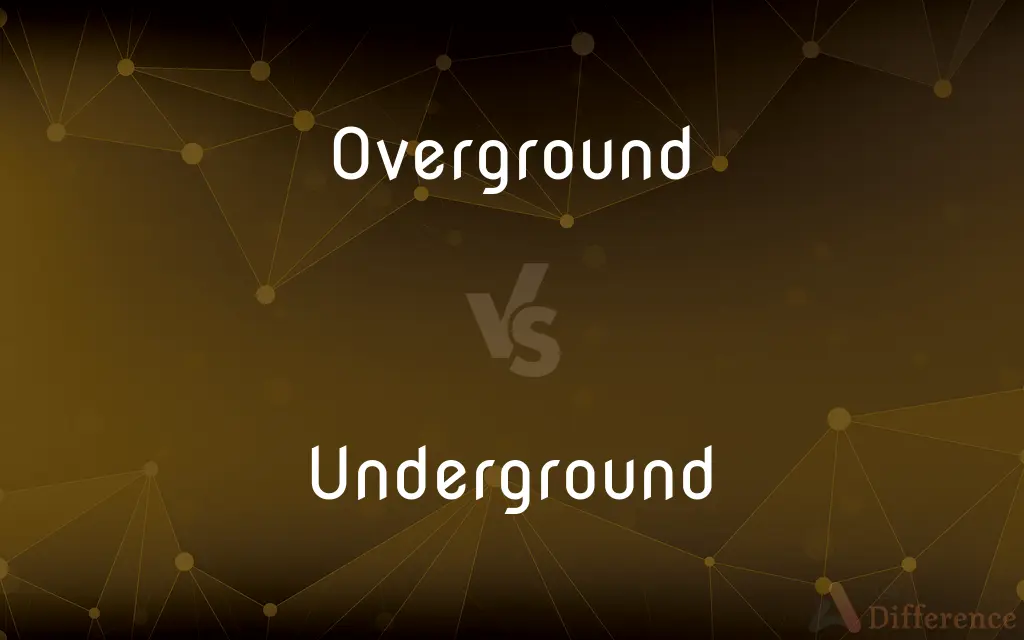Overground vs. Underground — What's the Difference?
By Maham Liaqat & Urooj Arif — Updated on April 1, 2024
The Overground refers to trains operating above ground, offering scenic routes and easier access, while the Underground operates below ground, focusing on speed and central urban connectivity.

Difference Between Overground and Underground
Table of Contents
ADVERTISEMENT
Key Differences
The Overground is part of urban rail services that operate on the surface, often integrating with other public transport networks to offer extensive coverage of suburban areas. Its stations are usually open-air, providing natural light and, in some cases, scenic views of the surrounding area. On the other hand, the Underground consists of subway or metro systems that run below the earth's surface. This design minimizes the system's footprint in densely populated areas, offering a fast, direct method of transportation that avoids surface traffic congestion.
While the Overground may offer more pleasant journeys with views and potentially less crowded conditions, it typically has lower frequencies and slower speeds compared to its subterranean counterpart. The Underground's design emphasizes efficiency and capacity, operating at high frequencies and speeds to move large numbers of passengers quickly through major urban centers.
Accessibility can vary significantly between the two, with Overground stations often featuring ground-level entrances without the need for extensive stairways or escalators. In contrast, Underground systems might require navigating multiple levels to reach platforms, although many modern systems include elevators and escalators to aid accessibility.
The Overground's infrastructure, including tracks and stations, is more exposed to weather conditions, which can occasionally disrupt service. Conversely, the Underground's operations are largely unaffected by weather, providing a more reliable option during adverse conditions.
Safety and security measures differ between the two, with the Underground often requiring more extensive surveillance and emergency planning due to its enclosed environment and higher passenger volumes. The Overground's more open and less crowded stations may pose different security challenges but generally allow for easier emergency evacuation.
ADVERTISEMENT
Comparison Chart
Environment
Operates above ground, often with open-air stations.
Operates below ground, with enclosed stations.
Speed & Frequency
Generally slower speeds and lower frequencies.
Higher speeds and more frequent service.
Accessibility
Easier access, often at ground level.
May require navigation of stairs/escalators.
Affected by Weather
More likely to be affected by adverse weather.
Largely unaffected by weather conditions.
Safety & Security
Different security challenges, easier evacuation.
Requires extensive surveillance, more complex evacuation.
Compare with Definitions
Overground
Integrates with Other Transport Modes
Buses and trams seamlessly connect at various Overground stations.
Underground
Subway or Metro Systems Below Ground
The city's Underground network efficiently bypasses surface traffic.
Overground
Rail Service Operating Above Ground
The Overground network offers panoramic views of the city's outskirts.
Underground
Dense Urban Area Operation
The Underground's design minimizes its footprint in crowded city centers.
Overground
Suburban and Peripheral Area Connectivity
The Overground serves as a vital link for suburban communities to the city center.
Underground
Enclosed and Multi-Level Stations
Underground stations feature extensive networks of tunnels and escalators.
Overground
Affected by Weather Conditions
Heavy snowfall can disrupt Overground services more than the Underground.
Underground
Reliability During Adverse Weather
The Underground maintains regular service, unaffected by external weather.
Overground
Open-Air Stations
The station's open-air design allows natural light and fresh air for passengers.
Underground
High-Speed Urban Connectivity
Commuters rely on the Underground for fast travel across the city.
Overground
Above the ground.
An overground railway
Underground
Situated, occurring, or operating below the surface of the earth
Underground caverns.
Underground missile sites.
Overground
A commuter rail or similar rail transport system, or a train in such systems, generally running above the ground.
Underground
Hidden or concealed; clandestine
Underground resistance to the tyrant.
Overground
Situated over or above ground; as, the overground portion of a plant.
Underground
Of or relating to an organization involved in secret or illegal activity
Underground trade in weapons.
Underground
Of or relating to an avant-garde movement or its films, publications, and art, usually privately produced and of special appeal and often concerned with social or artistic experiment.
Underground
A clandestine, often nationalist, organization fostering or planning hostile activities against, or the overthrow of, a government in power, such as an occupying military government
"an underground of dissident intellectuals" (Kenneth L. Woodward).
Underground
Chiefly British A subway system.
Underground
An avant-garde movement or publication.
Underground
Below the surface of the earth.
Underground
In secret; stealthily.
Underground
To situate under the ground
Workers undergrounding telephone lines.
Underground
(not comparable) Below the ground; below the surface of the Earth.
There is an underground tunnel that takes you across the river.
Underground
(figurative) Hidden, furtive, secretive.
These criminals operate through an underground network.
Underground
Outside the mainstream, especially unofficial and hidden from the authorities.
Underground music
Underground
Below the ground.
The tunnel goes underground at this point.
Underground
Secretly.
Underground
(geography) Regions beneath the surface of the earth, both natural (eg. caves) and man-made (eg. mines).
Underground
Syn of subway: a railway that is under the ground.
London Underground
Underground
A movement or organisation of people who resist political convention.
The French underground during World War II
Underground
A movement or organisation of people who resist artistic convention.
Underground
To route electricity distribution cables underground.
Underground
The place or space beneath the surface of the ground; subterranean space.
A spirit raised from depth of underground.
Underground
A subway or subway system, especially in the United Kingdom.
Underground
A secret organization opposed to the prevailing government; as, the French underground during the Nazi occupation.
Underground
A group or movement holding unorthodox views in an environment where conventional ideas dominate, as in artistic circles.
Underground
Being below the surface of the ground; as, an underground story or apartment.
Underground
Done or occurring out of sight; secret.
Underground
Beneath the surface of the earth.
Underground
A secret group organized to overthrow a government or occupation force
Underground
Electric underground railway
Underground
Under the level of the ground;
Belowground storage areas
Underground caverns
Underground
Conducted with or marked by hidden aims or methods;
Clandestine intelligence operations
Cloak-and-dagger activities behind enemy lines
Hole-and-corner intrigue
Secret missions
A secret agent
Secret sales of arms
Surreptitious mobilization of troops
An undercover investigation
Underground resistance
Underground
Used of independent armed resistance forces;
Guerrilla warfare
Partisan forces
Underground
In or into hiding or secret operation;
The organization was driven underground
Underground
Beneath the surface of the earth;
Water flowing underground
Common Curiosities
Can weather affect Overground services?
Yes, Overground services are more susceptible to disruptions due to adverse weather conditions.
Is the Underground less accessible than the Overground?
Often, yes, due to the need for navigating stairs or escalators to reach platforms.
Which is more reliable during bad weather, Overground or Underground?
The Underground is more reliable during adverse weather conditions as it is less affected.
Are both Overground and Underground included in city public transport passes?
Typically, yes, both modes are included in comprehensive public transport passes.
What is the main difference between Overground and Underground?
The Overground operates above ground, often with scenic routes, while the Underground operates below ground, focusing on speed and urban connectivity.
Are Overground trains slower than Underground?
Yes, Overground trains typically have slower speeds and lower frequencies compared to the Underground.
Do both Overground and Underground require the same level of security measures?
Both require security measures, but the Underground often requires more due to its enclosed spaces and higher passenger volumes.
Can tourists find it easier to navigate the city using Overground or Underground?
The Underground is usually faster for tourists, but the Overground can offer scenic views and a different experience.
Do Overground and Underground serve the same areas?
They may overlap in urban centers but generally serve different areas with the Overground focusing on suburban regions.
Is there a difference in ticket pricing between Overground and Underground?
Ticket pricing can vary based on the network and distance traveled, not necessarily the mode of transport.
Which has more stations, Overground or Underground?
This depends on the city, but generally, the Underground has more stations to cover dense urban areas.
Can bikes be taken on the Overground or Underground?
Policies vary, but bikes are often allowed on the Overground outside peak times and less so on the Underground.
Do Overground and Underground trains operate all night?
Service hours vary, with some cities offering night services for either or both, especially on weekends.
Are there any cities where Overground and Underground networks are completely separate?
In most cities, the networks are part of an integrated public transport system, though they may operate independently.
Which mode of transport is older, Overground or Underground?
Generally, Overground rail services predate Underground subway systems.
Share Your Discovery

Previous Comparison
Headset vs. Handset
Next Comparison
Culinary vs. CookingAuthor Spotlight
Written by
Maham LiaqatCo-written by
Urooj ArifUrooj is a skilled content writer at Ask Difference, known for her exceptional ability to simplify complex topics into engaging and informative content. With a passion for research and a flair for clear, concise writing, she consistently delivers articles that resonate with our diverse audience.














































